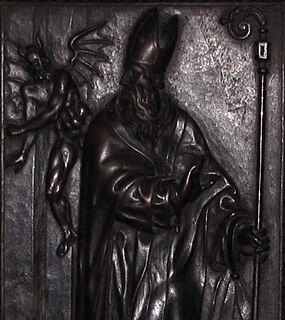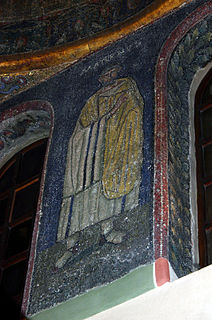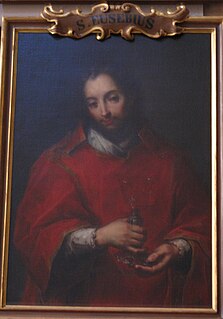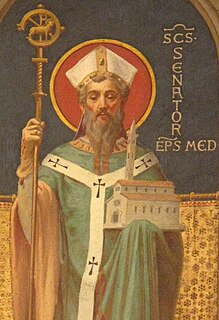Life
Almost nothing is known about the life of Venerius before his election as bishop of Milan. According to the 5th-century historian, Paulinus, Venerius was a deacon and he was present at the death of Ambrose in 397. Venerius was elected bishop after the death of Simplician in the winter between 400 and 401. He was already bishop of Milan when he received a request by a provincial synod held on June 18, 401 at Carthage to send in North Africa some clerics from Milan. One of the clerics sent was actually Paulinus. [2]
Venerius is also known from a letter written to him by Pope Anastasius I concerning the condemnation of the ideas of the Origenists. He is also mentioned in a letter of the same pope to John II, Bishop of Jerusalem. [2]
In 404 Venerius, along with Pope Innocent I and Chromatius, bishop of Aquileia, took a stand in favour of St. John Chrysostom who has been unjustly banned from Constantinople, writing in his favour to Honorius, the Western emperor, who sent this letter to his brother, Arcadius, the Eastern emperor. This intercession, however, availed nothing. [2]
Venerius died on May 4, 408, and he was buried in the Church of Saint Nazarius and Celsus in Milan. [3] A late tradition, with no historical basis, associates Venerius with the Milan's family of the Oldrati.
Pope Zosimus was the bishop of Rome from 18 March 417 to his death on 26 December 418. He was born in Mesoraca, Calabria. Zosimus took a decided part in the protracted dispute in Gaul as to the jurisdiction of the See of Arles over that of Vienne, giving energetic decisions in favour of the former, but without settling the controversy. His fractious temper coloured all the controversies in which he took part, in Gaul, Africa and Italy, including Rome, where at his death the clergy were very much divided.

The Archdiocese of Milan is a metropolitan see of the Catholic Church in Italy which covers the areas of Milan, Monza, Lecco and Varese. It has long maintained its own Latin liturgical rite, the Ambrosian rite, which is still used in the greater part of the diocesan territory. Among its past archbishops, the better known are Saint Ambrose, Saint Charles Borromeo, Pope Pius XI and Saint Pope Paul VI.

Simplician was Bishop of Milan from 397 to 400 or 401 AD. He is honoured as a Saint in the Roman Catholic and Eastern Orthodox Churches and his feast day is August 14.

Dacius or Datius was Bishop of Milan from c. 530 to 552. He is honoured as a saint in the Catholic Church.

Marolus was Archbishop of Milan from 408 to 423. He is honoured as a Saint in the Catholic Church and his feast day is April 23.

Benedict was Archbishop of Milan from c. 685 to c. 732. He is honoured as a saint in the Catholic Church.

Maternus was Archbishop of Milan from c. 316 to c. 328. He is honoured as a Saint in the Catholic Church and his feast day is on July 18.

Glycerius was Archbishop of Milan from 436 to 438. He is honoured as a Saint in the Catholic Church and Eastern Orthodox Church.

Castritian was Bishop of Milan in mid 3rd-century. He is honoured as a Saint in the Catholic Church and his feast day is on December 1.

Eusebius was Archbishop of Milan from 449 to 462. He is honoured as a saint and his feast day is 12 August.

Senator of Milan or Senator of Settala was Bishop of Milan from 472 to 475. He is honoured as a saint in the Eastern Orthodox Church and Catholic Church and his feast day is 28 May.

Martinianus was Archbishop of Milan from 423 to 435. He is honoured as a Saint in the Catholic Church and his feast day is 2 January.

Gerontius was Archbishop of Milan from 462 to 465. He is honoured as a Saint in the Catholic Church and his feast day is 5 May.
Benignus was Archbishop of Milan from 465 to 472. He is honoured as a Saint in the Catholic Church and his feast day is September 20.

Dionysius was bishop of Milan from 349 to 355. He is honoured as a Saint in the Catholic and Eastern Orthodox Churches and his feast day is on May 25.

Protasius was Archbishop of Milan. He is honored as a saint in the Catholic Church, with his feast day celebrated on 24 November, the day of his death.

Mirocles was Bishop of Milan from before 313 to c. 316. He is honoured as a Saint in the Catholic Church and his feast day is on December 3.

Anathalon was the first recorded Bishop of Milan and lived at the end 2nd-century or early 3rd-century. He is honoured as a Saint in the Catholic Church and his feast day is on September 25 in Milan. A late tradition made him the first bishop of Brescia where his feast day is celebrated on September 24.
Lawrence I was Archbishop of Milan from 490 to c. 511. He is honoured as a saint in the Catholic Church and his feast day is July 25.

Mansuetus was Archbishop of Milan from 676 to 685. He is honoured as a saint in the Catholic Church.
This page is based on this
Wikipedia article Text is available under the
CC BY-SA 4.0 license; additional terms may apply.
Images, videos and audio are available under their respective licenses.

















